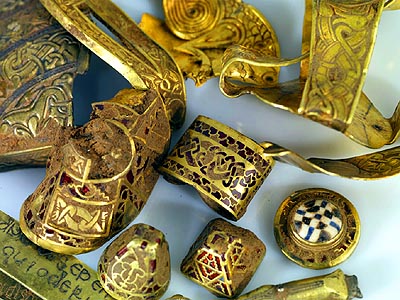|

|
|

Gold and jewels dug
up in a field.
 In the Summer of 2009, a
man with a metal-detector found a large 'hoard' (a collection)
of Anglo-Saxon objects in a field near Lichfield in
Staffordshire. In the Summer of 2009, a
man with a metal-detector found a large 'hoard' (a collection)
of Anglo-Saxon objects in a field near Lichfield in
Staffordshire.- There were 1,500
objects. Most were gold, some silver and many inlaid with
gemstones. They weighed 6.3 kg. That's nearly 4 times the
weight of the gold from Sutton Hoo.
- Archaeologists recognise
many of the objects. Some are very similar to objects found at
Sutton Hoo. Like Sutton Hoo, the Staffordshire discovery dates
from the 7th century.
- All the objects from the
Staffordshire Hoard are parts of bigger items. They have been
broken off.
- Most of them seem to be
parts of weapons or armour. There are pieces from helmets and
particularly from swords. There are 71 collars and 136 plates
from sword hilts (handles) and 84 sword pommels (knobs on the
ends of the handles). There are also toggles like those from
the scabbard at Sutton Hoo.
- There were also Christian
objects: an inscription from the Bible and two crosses.
One large one was all screwed up.
- Some objects were
inlaid with coloured glass using a technique called 'millefiori';
or garnets (red jewels) using a
technique called 'cloisonné work'. Some of the gold was
decorated with tiny 'fillgree
work' (patterns of gold wire) or entwined animal patterns like
those in Anglo-Saxon manuscripts.
- Most of the objects are
just strips of gold to decorate the edges of something. Many
are still to be identified (recognised for what they are).
- Archaeologists still
don't know why someone would bury all these bit of weapons.
But they have some ideas.
-
Activity
Sheets available.
|
|

